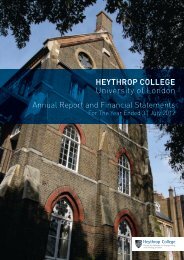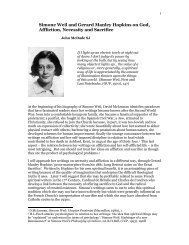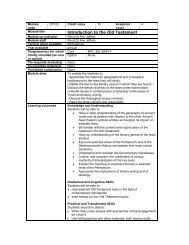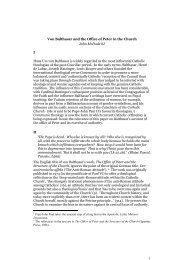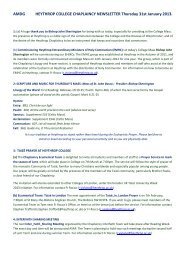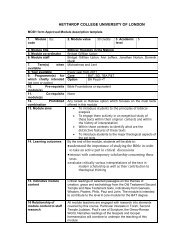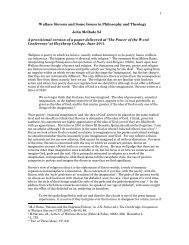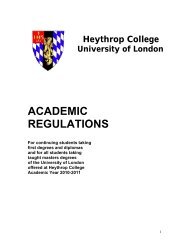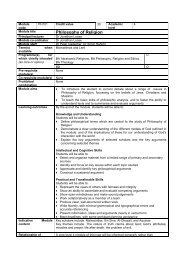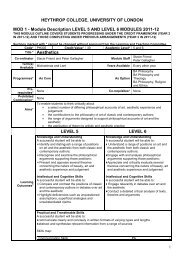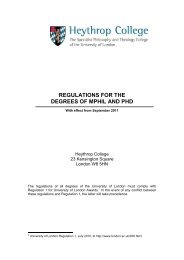December 2010: Edition 8 - Heythrop College
December 2010: Edition 8 - Heythrop College
December 2010: Edition 8 - Heythrop College
Create successful ePaper yourself
Turn your PDF publications into a flip-book with our unique Google optimized e-Paper software.
A t t h e h e a r t o f H e y t h r o p<br />
No doubt home to many of us during out time at <strong>Heythrop</strong>, the <strong>College</strong> Library is by turn a most familiar place, and one associated with m<br />
history of the <strong>College</strong>’s Library over its almost-four hundred year history, and gives<br />
6<br />
Most <strong>Heythrop</strong> Alumni will be familiar<br />
with the basic outline of the history of<br />
the <strong>College</strong> and its Library. The <strong>College</strong><br />
was established in 1614 for the training<br />
of Jesuits for the English Mission in<br />
Philosophy and Theology. This was a time<br />
when being a Jesuit in England was a<br />
capital offence, so the <strong>College</strong> was<br />
founded in Louvain but quickly moved to<br />
Liege. A 17 th century visitor to the<br />
library at Liege described it as “useful<br />
rather than fine” but it was sufficiently<br />
useful for P. Watts, writing in 1917 to say<br />
that many of the Liege books were still in<br />
use in 1917. Many of these books are<br />
now housed in the University of London<br />
Depository Library at Egham and in many<br />
cases we have the only copy of the<br />
particular volume in the country.<br />
Despite the suppression of the Jesuits in<br />
1773 the <strong>College</strong> continued in existence<br />
thanks to the support of the Prince<br />
Bishop of Liege. However, with the<br />
arrival of the revolutionary armies in<br />
1794 the <strong>College</strong> had to flee, together<br />
with the school which had earlier joined<br />
it from St.Omers. It travelled to, a now<br />
more tolerant, England, although in the<br />
process part of the Library was left<br />
behind on the docks. However, quite a<br />
few of the books now in the collection<br />
made the journey. The <strong>College</strong><br />
established itself at Stonyhurst in<br />
Lancashire and in 1803 the former Jesuits<br />
were able to rejoin the remnant of the<br />
Society of Jesus which had survived in<br />
Russia.<br />
The Library at Cavendish Square<br />
At various times in its history the <strong>College</strong><br />
also taught Philosophy, in its broad<br />
sense, to lay men as well as Jesuit<br />
students. With the establishment of the<br />
University of London the <strong>College</strong> the<br />
<strong>College</strong> began to prepare both groups for<br />
London external degrees. The collection<br />
has inherited books<br />
on a wide range of<br />
topics from this<br />
time as well as from<br />
later general studies<br />
courses undertaken<br />
by Jesuit students at<br />
the beginning of<br />
their training. The<br />
Collection includes a<br />
wide range of<br />
d o n a t i o n s , i n<br />
p a r t i c u l a r t h e<br />
library of E.<br />
B a d d e l e y a<br />
s p e c i a l i s t i n<br />
ecclesiastical law.<br />
By 1848 numbers had expanded and<br />
theology moved to St. Beuno‟s in North<br />
Wales with Philosophy staying at<br />
Stonyhurst. It was at St. Beuno‟s that<br />
the poet Gerard Manley Hopkins did his<br />
theology. According to Watts, by 1917<br />
the St. Beuno‟s library held 31,062 bound<br />
volumes. Unfortunately the library staff<br />
do not have the leisure to conduct such a<br />
precise census today.<br />
In the nineteenth century roles had been<br />
reversed, Britain was a home to various<br />
“asylum seekers”, and it was not just<br />
English Province Jesuits who did their<br />
studies in Britain. At various times<br />
exiled Jesuits from France and Germany<br />
set up <strong>College</strong>s at Ditton, Hastings, Mold<br />
and on Jersey, Teilhard de Chardin, for<br />
example, studied at Hastings and Jersey.<br />
There are some books in the Library from<br />
these establishments too.<br />
By 1926 student numbers had again<br />
grown and it was felt it would be better<br />
to reunite Philosophy and Theology on a<br />
new site. <strong>Heythrop</strong> House in Oxfordshire<br />
was purchased for the purpose and the<br />
Jesuits moved in. A subsequent note on<br />
the library at <strong>Heythrop</strong> records “It will<br />
readily believed that to rearrange and<br />
recatalogue the books in their new<br />
domicile was the work of many months”.<br />
It is from this incarnation that the<br />
<strong>College</strong> takes its name. It is clear from<br />
a look at the collection that the Library<br />
also took in the libraries of a number of<br />
other Jesuit institutions now closed. For<br />
example some parishes ran general<br />
lending libraries in the days before<br />
municipal public libraries were quite so<br />
The check-out desk in Kensington Square; picture by N Kay<br />
common. By 1938 the library held 58,000<br />
books.<br />
In the 1960s the <strong>College</strong> became a<br />
Pontifical Athenaeum, able to give its<br />
own Roman Catholic Pontifical Degrees<br />
(previously its Philosophy and Theology<br />
degrees had been those of the Gregorian<br />
University). It opened up to members of<br />
other religious orders and to lay people.<br />
As part of this expansion a new, purpose<br />
built library was opened with space for<br />
400,000 volumes. However, this was just<br />
at the time when the numbers entering<br />
religious life plummeted and the whole<br />
approach to their training changed.<br />
What is more there was a desire to open<br />
up the <strong>College</strong> to far more lay people,<br />
who would be looking for British degrees<br />
offered by a British University. The<br />
<strong>College</strong>, therefore, became part of the<br />
University of London and in 1970 moved<br />
into the former teacher training <strong>College</strong><br />
in Cavendish Square off Oxford Circus.<br />
The Reading Room at Cavendish Square



